Synthesis of Climate, Soil Factors, and Nitrogen Management Practices Affecting the Responses of Wheat Productivity and Nitrogen Use Efficiency to Nitrogen Fertilizer in China
Abstract
:1. Introduction
2. Materials and Methods
2.1. Data Collection
2.2. Building the Datasets
2.3. Meta-Analysis
2.4. Regression Analysis
3. Results
3.1. Overview of the Wheat N Application Rate, Yields, and NUE
3.2. Yield and NUE by Region and Climate
3.3. Impact of Soil Texture, Total N, Available N, and pH
3.4. Impact of N Management Practices
4. Discussion
4.1. Climate
4.2. Soil Factors
4.3. N Management Practices
4.4. Limitations
5. Conclusions
Supplementary Materials
Author Contributions
Funding
Acknowledgments
Conflicts of Interest
References
- Cui, Z.; Zhang, F.; Chen, X.; Dou, Z.; Li, J. In-season nitrogen management strategy for winter wheat: Maximizing yields, minimizing environmental impact in an over-fertilization context. Field Crops Res. 2010, 116, 140–146. [Google Scholar] [CrossRef]
- Zhou, X.; Wang, H.; Chen, Q.; Ren, J. Coupling effects of depth of film-bottomed tillage and amount of irrigation and nitrogen fertilizer on spring wheat yield. Soil Tillage Res. 2007, 94, 251–261. [Google Scholar] [CrossRef]
- Guo, S.; Zhu, H.; Dang, T.; Wu, J.; Liu, W.; Hao, M.; Li, Y.; Syers, J.K. Winter wheat grain yield associated with precipitation distribution under long-term nitrogen fertilization in the Semiarid Loess Plateau in China. Geoderma 2012, 189–190, 442–450. [Google Scholar] [CrossRef]
- Dai, J.; Wang, Z.; Li, M.; He, G.; Li, Q.; Cao, H.; Wang, S.; Gao, Y.; Hui, X. Winter wheat grain yield and summer nitrate leaching: Long-term effects of nitrogen and phosphorus rates on the Loess Plateau of China. Field Crops Res. 2016, 196, 180–190. [Google Scholar] [CrossRef]
- Fang, Q.; Yu, Q.; Wang, E.; Chen, Y.; Zhang, G.; Wang, J.; Li, L. Soil nitrate accumulation, leaching and crop nitrogen use as influenced by fertilization and irrigation in an intensive wheat–maize double cropping system in the North China Plain. Plant Soil 2006, 284, 335–350. [Google Scholar] [CrossRef] [Green Version]
- Wang, Z.H.; Miao, Y.F.; Li, S.X. Effect of ammonium and nitrate nitrogen fertilizers on wheat yield in relation to accumulated nitrate at different depths of soil in drylands of China. Field Crops Res. 2015, 183, 211–224. [Google Scholar] [CrossRef]
- Liu, R.; Kang, Y.; Pei, L.; Wan, S.; Liu, S.; Liu, S. Use of a new controlled-loss-fertilizer to reduce nitrogen losses during winter wheat cultivation in the Danjiangkou Reservoir Area of China. Commun. Soil Sci. Plant Anal. 2016, 47, 1137–1147. [Google Scholar] [CrossRef]
- Fan, X.; Li, F.; Liu, F.; Kumar, D. Fertilization with a new type of coated urea: Evaluation for nitrogen efficiency and yield in winter wheat. J. Plant Nutr. 2004, 27, 853–865. [Google Scholar] [CrossRef]
- Li, W.; Han, X.; Zhang, Y.; Li, Z. Effects of elevated CO2 concentration, irrigation and nitrogenous fertilizer application on the growth and yield of spring wheat in semi-arid areas. Agric. Water Manag. 2007, 87, 106–114. [Google Scholar] [CrossRef]
- Zheng, W.; Liu, Z.; Zhang, M.; Shi, Y.; Zhu, Q.; Sun, Y.; Zhou, H.; Li, C.; Yang, Y.; Geng, J. Improving crop yields, nitrogen use efficiencies, and profits by using mixtures of coated controlled-released and uncoated urea in a wheat-maize system. Field Crops Res. 2017, 205, 106–115. [Google Scholar] [CrossRef]
- Schulz, R.; Makary, T.; Hubert, S.; Hartung, K.; Gruber, S.; Donath, S.; Döhler, J.; Weiβ, K.; Ehrhart, E.; Claupein, W.; et al. Is it necessary to split nitrogen fertilization for winter wheat? On-farm research on luvisols in south-west Germany. J. Agric. Sci. 2015, 153, 575–587. [Google Scholar] [CrossRef]
- Geleto, T.; Tanner, D.G.; Mamo, T.; Gebeyehu, G. Response of rainfed bread and durum wheat to source, level, and timing of nitrogen fertilizer on two ethiopian vertisols. 1. yield and yield components. Commun. Soil Sci. Plant. Anal. 2008, 26, 1773–1794. [Google Scholar] [CrossRef]
- Yi, Q.; He, P.; Zhang, X.Z.; Yang, L.; Xiong, G.Y. Optimizing fertilizer nitrogen for winter wheat production in Yangtze River region in China. J. Plant Nutr. 2015, 38, 1639–1655. [Google Scholar] [CrossRef]
- Miguez, F.H.; Pérez, A.A.; Frasco, J.A.; Zapiola, M.L. Meta-analysis of nitrogen fertilization effects on wheat grain protein in Argentina. Open Sci. Repos. Agric. 2013, e70081981. [Google Scholar] [CrossRef]
- Abalos, D.; Jeffery, S.; Sanz-Cobena, A.; Guardia, G.; Vallejo, A. Meta-analysis of the effect of urease and nitrification inhibitors on crop productivity and nitrogen use efficiency. Agric. Ecosyst. Environ. 2014, 189, 136–144. [Google Scholar] [CrossRef]
- Pelzer, E.; Hombert, N.; Jeuffroy, M.; Makowski, D. Meta-analysis of the effect of nitrogen fertilization on annual cereal–legume intercrop production. Agron. J. 2015, 106, 1775–1786. [Google Scholar] [CrossRef]
- Ding, W.; Xu, X.; He, P.; Ullah, S.; Zhang, J.; Cui, Z.; Zhou, W. Improving yield and nitrogen use efficiency through alternative fertilization options for rice in China: A meta-analysis. Field Crops Res. 2018, 227, 11–18. [Google Scholar] [CrossRef]
- Hedges, L.V.; Gurevitch, J.; Curtis, P.S. The meta-analysis of response ratios in experimental ecology. Ecology 1999, 80, 1150–1156. [Google Scholar] [CrossRef]
- Dobermann, A.R. Nitrogen Use Efficiency—State of the Art. Agronomy & Horticulture—Faculty Publications. 2005. Available online: http://digitalcommons.unl.edu/agronomyfacpub/316 (accessed on 20 September 2018).
- Tummers, B. DataThief III. 2006. Available online: http://datathief.org/ (accessed on 20 August 2017).
- Daryanto, S.; Wang, L.; Jacinthe, P.A. Global synthesis of drought effects on food legume production. PLoS ONE 2015, 10, e0127401. [Google Scholar] [CrossRef] [PubMed] [Green Version]
- Adams, D.C.; Gurevitch, J.; Rosenberg, M.S. Resampling tests for meta-analysis of ecological data. Ecology 1997, 78, 1277–1283. [Google Scholar] [CrossRef]
- Wang, Y.; Zhang, Y.; Zhou, S.; Wang, Z. Meta-analysis of no-tillage effect on wheat and maize water use efficiency in China. Sci. Total Environ. 2018, 635, 1372–1382. [Google Scholar] [CrossRef] [PubMed]
- Nyiraneza, J.; Cambouris, A.N.; Ziadi, N.; Tremblay, N.; Nolin, M.C. Spring wheat yield and quality related to soil texture and nitrogen fertilization. Agron. J. 2012, 104, 589–599. [Google Scholar] [CrossRef]
- Satorre, E.H.; Slafer, G.A. (Eds.) Wheat: Ecology and Physiology of Yield Determination; Food Products Press: New York, NY, USA, 1999; p. 503. [Google Scholar]
- Farooq, M.; Bramley, H.; Palta, J.A.; Siddique, K.H.M. Heat stress in wheat during reproductive and grain-filling phases. Crit. Rev. Plant Sci. 2011, 30, 491–507. [Google Scholar] [CrossRef]
- Ferris, R.; Ellis, R.H.; Wheeler, T.R.; Hadley, P. Effect of high temperature stress at anthesis on grain yield and biomass of field-grown crops of wheat. Ann. Bot. 1998, 82, 631–639. [Google Scholar] [CrossRef]
- Hatfield, J.L.; Boote, K.J.; Kimball, B.A.; Ziska, L.H.; Izaurralde, R.C.; Ort, D.; Thomson, A.M.; Wolfe, D. Climate impacts on agriculture: Implications for crop production. Agron. J. 2011, 103, 351–370. [Google Scholar] [CrossRef]
- Zhang, H.; Oweis, T. Water–yield relations and optimal irrigation scheduling of wheat in the Mediterranean region. Agric. Water Manag. 1999, 38, 195–211. [Google Scholar] [CrossRef]
- Takashima, N.E.; Rondanini, D.P.; Puhl, L.E.; Miralles, D.J. Environmental factors affecting yield variability in spring and winter rapeseed genotypes cultivated in the southeastern argentine pampas. Eur. J. Agron. 2013, 48, 88–100. [Google Scholar] [CrossRef]
- Unger, P.W.; Payne, W.A.; Peterson, G.A. Water conservation and efficient use. In Dryland Agriculture; Peterson, G.A., Unger, P.W., Payne, W.A., Eds.; Agronomy Monograph 23; American Society of Agronomy, Crop Science Society of America, Soil Science Society of America: Madison, WI, USA, 2006; pp. 39–86. [Google Scholar]
- Schillinger, W.F.; Schofstoll, S.E.; Alldredge, J.R. Available water and wheat grain yield relations in a Mediterranean climate. Field Crops Res. 2008, 109, 45–49. [Google Scholar] [CrossRef]
- Meyer, N.; Welp, G.; Rodionov, A.; Borchard, N.; Martius, C.; Amelung, W. Nitrogen and phosphorus supply controls soil organic carbon mineralization in tropical topsoil and subsoil. Soil Biol. Biochem. 2018, 119, 152–161. [Google Scholar] [CrossRef]
- Zinn, Y.L.; Andrade, A.B.; Araujo, M.A.; Lal, R. Soil organic carbon retention more affected by altitude than texture in a forested mountain range in Brazil. Soil Res. 2018, 56, 284–295. [Google Scholar] [CrossRef]
- Shah, G.A.; Shah, G.M.; Rashid, M.I.; Jcj, G.; Traore, B.; Lantinga, E.A. Bedding additives reduce ammonia emission and improve crop N uptake after soil application of solid cattle manure. J. Environ. Manag. 2018, 209, 195–204. [Google Scholar] [CrossRef] [PubMed]
- D’Hose, T.; Molendijk, L.; Vooren, L.V.; Berg, W.V.D.; Hoek, H.; Runia, W.; van Evert, F.; ten Berge, H.; Spiegel, H.; Sandèn, T.; et al. Responses of soil biota to non-inversion tillage and organic amendments: An analysis on European multiyear field experiments. Pedobiologia 2018, 66, 18–28. [Google Scholar] [CrossRef]
- Pandiaraj, T.; Selvaraj, S.; Ramu, N. Effects of crop residue management and nitrogen fertilizer on soil nitrogen and carbon content and productivity of wheat (Triticum aestivum L.) in two cropping systems. J. Agric. Sci. Technol. 2018, 17, 249–260. [Google Scholar]
- Aula, L.; Macnack, N.; Omara, P.; Mullock, J.; Raun, W. Effect of fertilizer nitrogen (N) on soil organic carbon, total N, and soil pH in long-term continuous winter wheat (Triticum aestivum L.). Commun. Soil Sci. Plant Anal. 2016, 47, 1–11. [Google Scholar] [CrossRef]
- Singh, J.; Bolan, N.S.; Saggar, S.; Zaman, M. The role of inhibitors in controlling the bioavailability and losses of nitrogen. In Chemicals Bioavailability in Terres-Trial Environment; Elsevier: Amsterdam, The Netherlands, 2008; pp. 329–362. [Google Scholar]
- Kim, D.G.; Saggar, S.; Roudier, P. The effect of nitrification inhibitors on soil ammonia emissions in nitrogen managed soils: A meta-analysis. Nutr. Cycl. Agroecosyst. 2012, 93, 51–64. [Google Scholar] [CrossRef]
- Linquist, B.A.; Lijun, L.; van Kessel, C.; van Groenigen, K.J. Enhanced efficiency nitrogen fertilizers for rice systems: Meta-analysis of yield and nitrogen uptake. Field Crops Res. 2013, 154, 246–254. [Google Scholar] [CrossRef]
- Fowler, D.B.; Brydon, J.; Darroch, B.A.; Entz, M.H.; Johnston, A.M. Environment and genotype influence on grain protein concentration of wheat and rye. Agron. J. 1990, 82, 655–664. [Google Scholar] [CrossRef]
- Behera, S.K.; Panda, R.K. Effect of fertilization and irrigation schedule on water and fertilizer solute transport for wheat crop in a sub-humid sub-tropical region. Agric. Ecosyst. Environ. 2009, 130, 141–155. [Google Scholar] [CrossRef]
- Basso, B.; Cammarano, D.; Troccoli, A.; Chen, D.; and Ritchie, J.T. Long-term wheat response to nitrogen in a rainfed Mediterranean environment: Field data and simulation analysis. Eur. J. Agron. 2010, 33, 132–138. [Google Scholar] [CrossRef]
- Gooding, M.J.; Davies, W.P. Foliar urea fertilization of cereals: A review. Fertil. Res. 1992, 32, 209–222. [Google Scholar] [CrossRef]
- Hu, H.Y.; Ning, T.Y.; Li, Z.J.; Han, H.F.; Zhang, Z.Z.; Qin, S.J.; Zheng, Y.H. Coupling effects of urea types and subsoiling on nitrogen-water use and yield of different varieties of maize in northern China. Field Crops Res. 2013, 142, 85–94. [Google Scholar] [CrossRef]
- Guo, Z.; Zhang, Y.; Zhao, J.; Shi, Y.; Yu, Z. Nitrogen use by winter wheat and changes in soil nitrate nitrogen levels with supplemental irrigation based on measurement of moisture content in various soil layers. Field Crops Res. 2014, 164, 117–125. [Google Scholar] [CrossRef]
- Martre, P.; Porter, J.P.; Jamieson, P.D.; Triboi, E. Modelling grain nitrogen accumulation and protein composition to understand the sink/source regulation of nitrogen remobilisation for wheat. Plant Physiol. 2003, 133, 1959–1967. [Google Scholar] [CrossRef] [PubMed]
- Grant, C.A.; Wu, R.; Selles, F.; Harker, K.N.; Clayton, G.W.; Bittman, S.; Zebarth, B.J.; Lupway, N.Z. Crop yield and nitrogen concentration with controlled release urea and split applications of nitrogen as compared to non-coated urea applied at seeding. Field Crops Res. 2012, 127, 170–180. [Google Scholar] [CrossRef]
- Li, P.; Lu, J.; Wang, Y.; Wang, S.; Hussain, S.; Ren, T.; Cong, R.; Li, X. Nitrogen losses, use efficiency, and productivity of early rice under controlled-release urea. Agric. Ecosyst. Environ. 2018, 251, 78–87. [Google Scholar] [CrossRef]
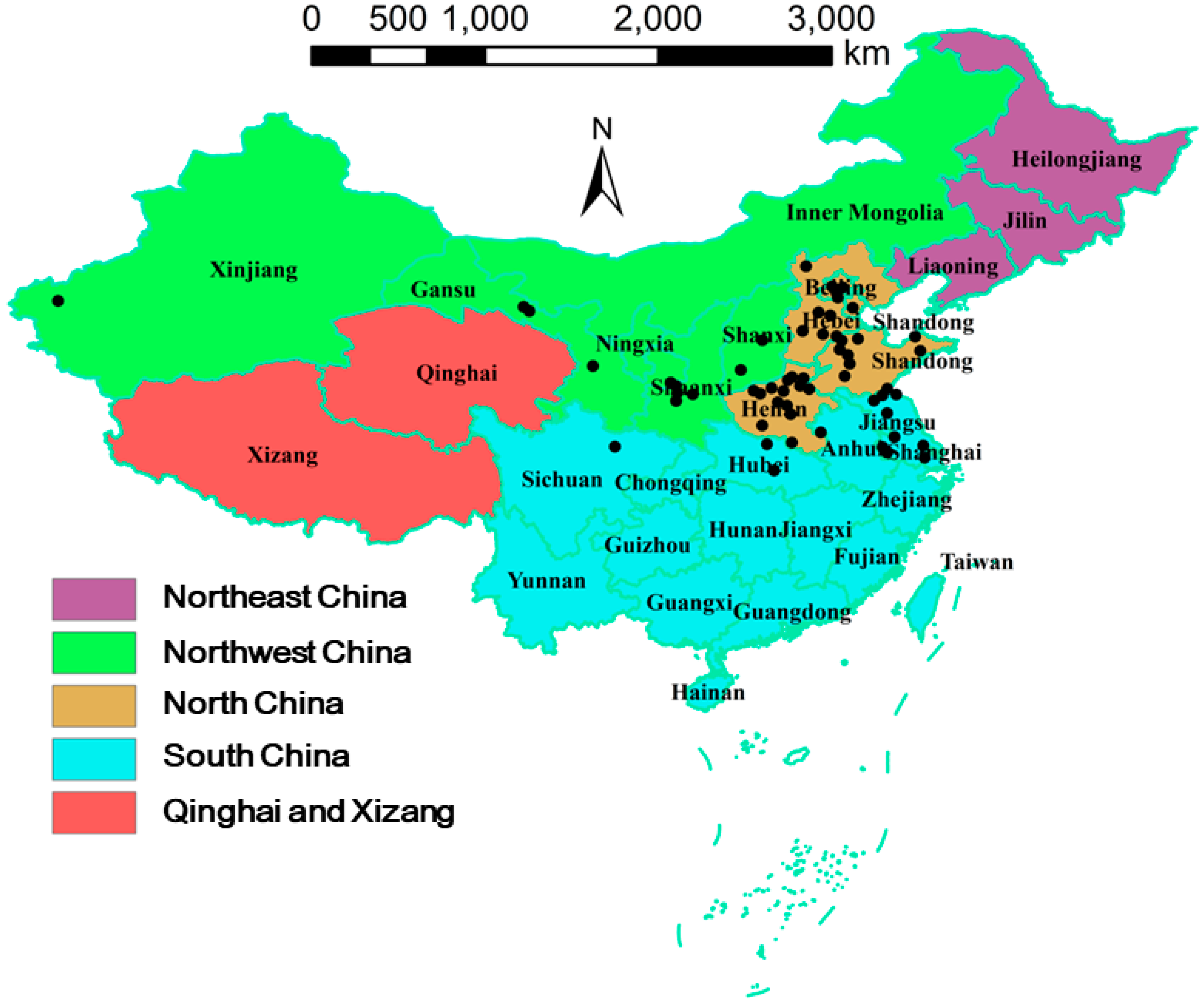




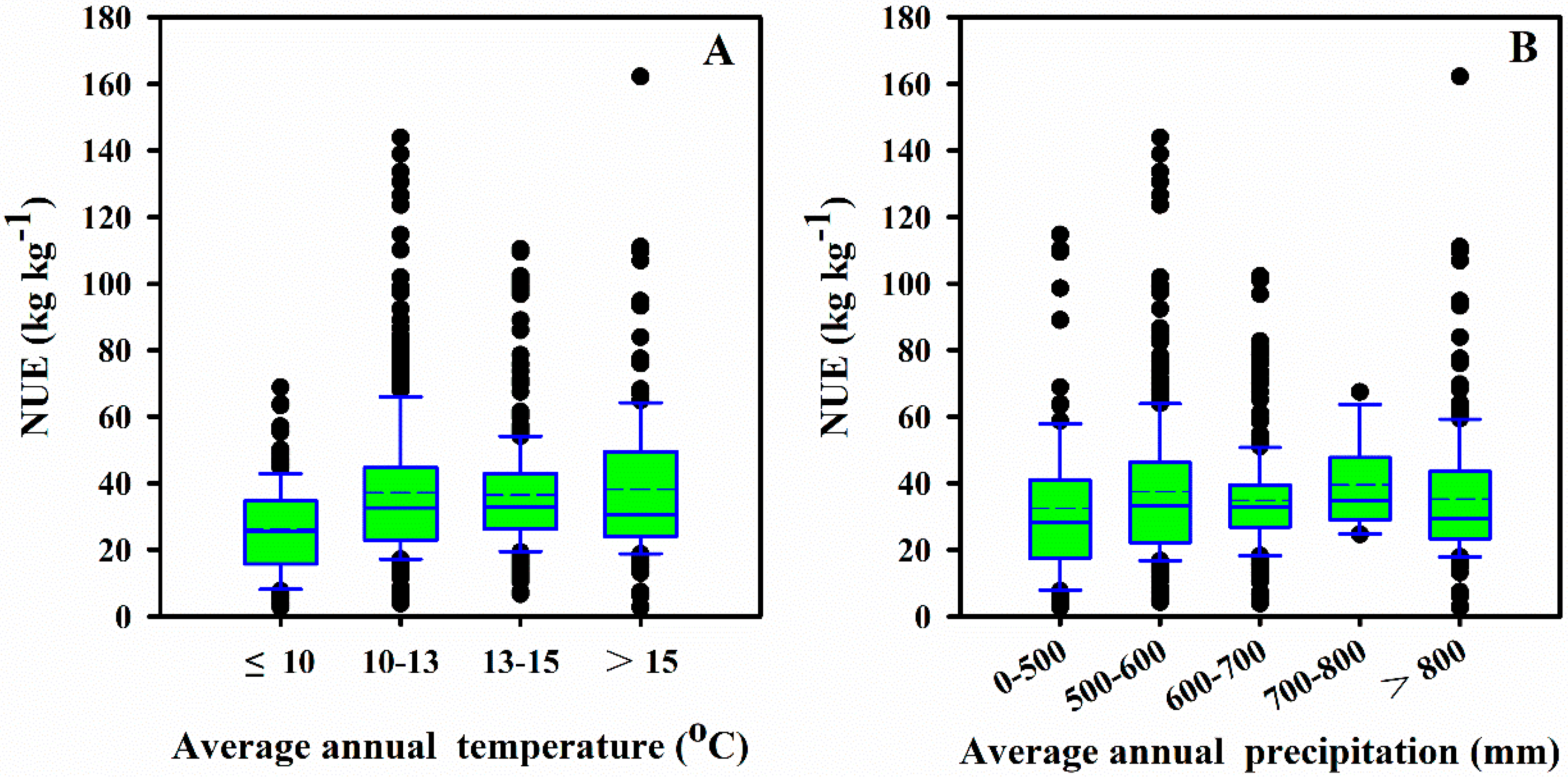


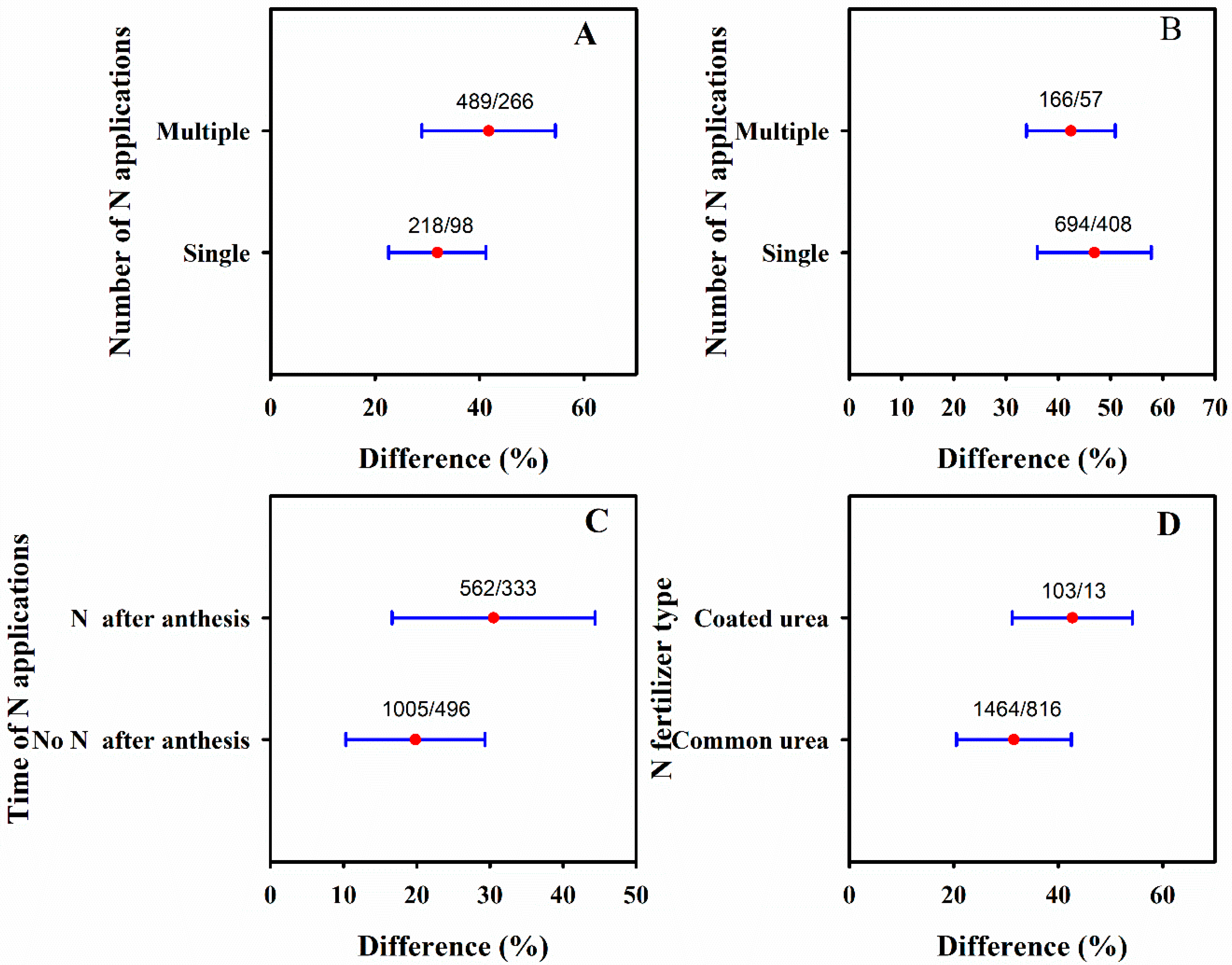
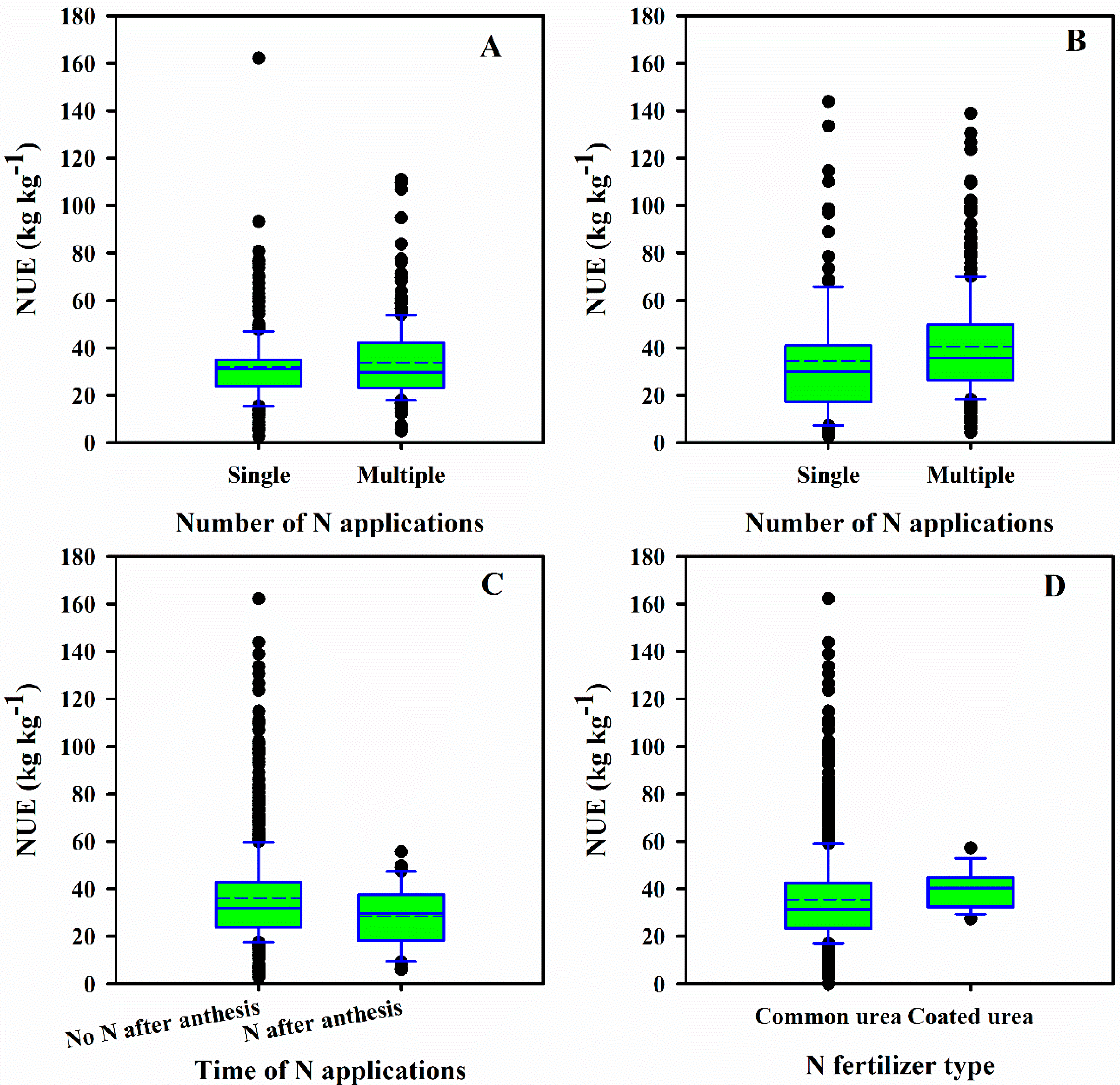

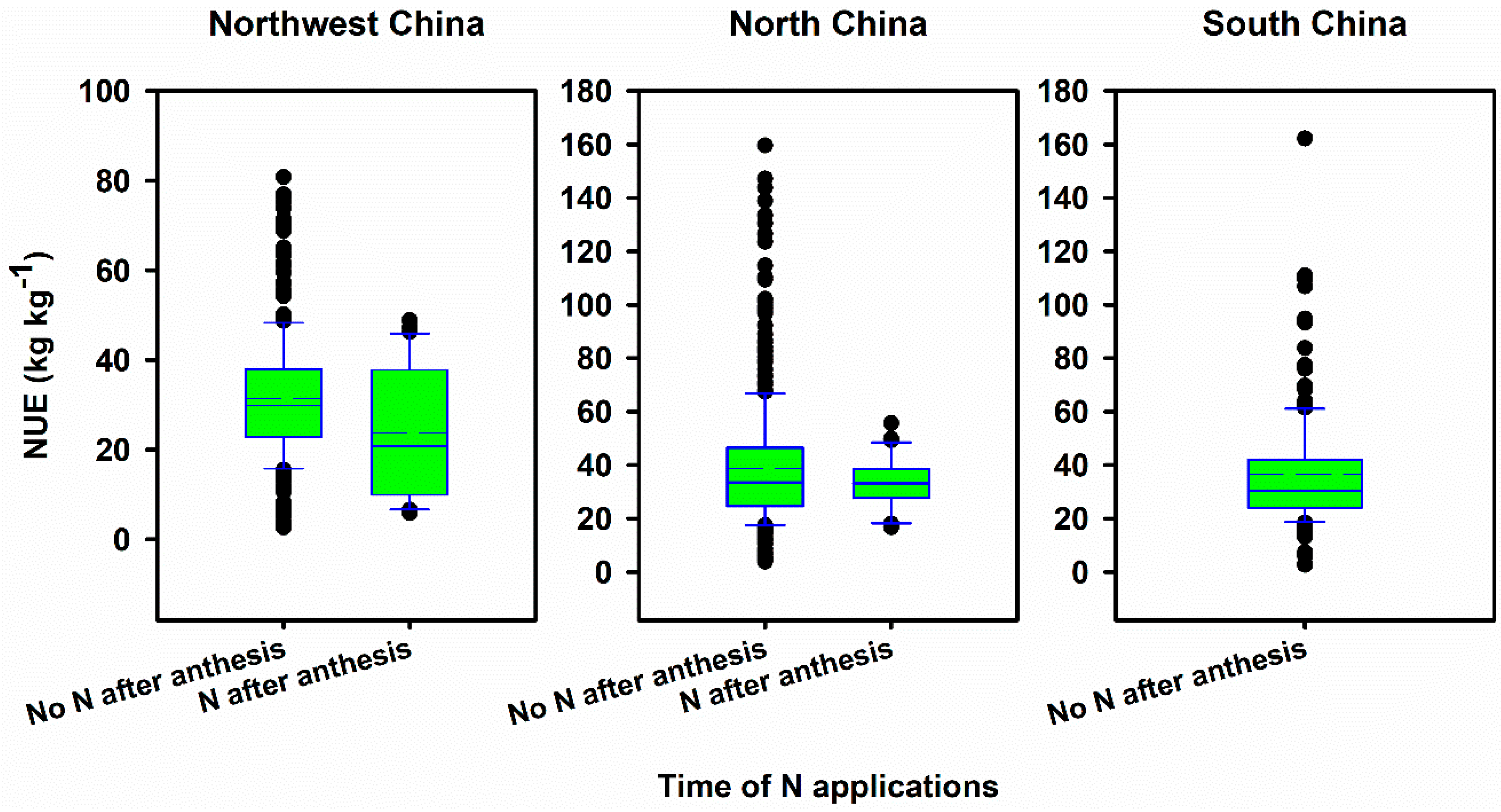

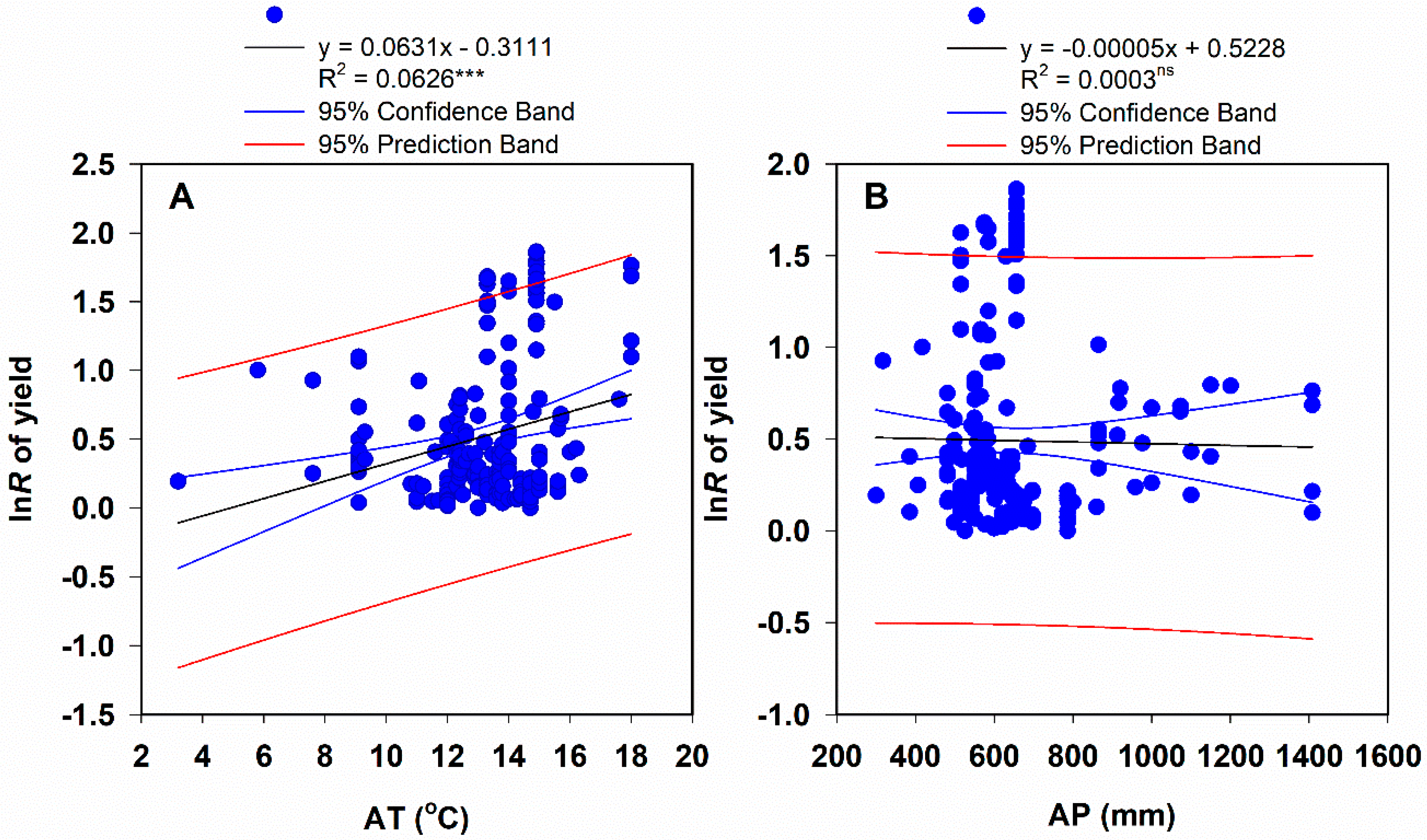

| Regions | N Management Practices | Yield | Ear Number | Kernel Number per Ear | Thousand-Kernel Weight | |||||
|---|---|---|---|---|---|---|---|---|---|---|
| ES | 95% CI | ES | 95% CI | ES | 95% CI | ES | 95% CI | |||
| Northwest China | Number of N applications | Single | 0.437 | 35.7–51.7 | 0.192 | 14.4–23.9 | 0.206 | 13.7–27.4 | −0.375 | −61.6–−13.4 |
| Multiple | 0.498 | 42.0–57.6 | 0.009 | −1.0–2.7 | 0.184 | 14.3–22.6 | −0.042 | −8.0–−0.4 | ||
| Time of N application | No N after anthesis | 0.429 | 36.7–49.1 | 0.094 | 6.1–12.8 | 0.168 | 15.0–18.7 | −0392 | −55.1–−23.3 | |
| N after anthesis | 0.644 | 45.8–82.9 | NA | NA | NA | NA | NA | NA | ||
| N fertilizer type | Common urea | 0.316 | 15.5–47.7 | NA | NA | NA | NA | NA | NA | |
| Coated urea | 0.449 | 15.6–74.2 | NA | NA | NA | NA | NA | NA | ||
| North China | Number of N applications | Single | 0.311 | 27.0–35.1 | 0.231 | 12.9–33.2 | 0.110 | 7.4–14.7 | 0.175 | 6.7–28.2 |
| Multiple | 0.330 | 30.4–35.7 | 0.182 | 16.2–20.2 | 0.168 | 15.7–17.9 | 0.023 | 1.1–3.5 | ||
| Time of N application | No N after anthesis | 0.331 | 30.7–35.4 | 0.199 | 12.7–27.0 | 0.160 | 14.0–18.0 | 0.199 | 12.7–27.0 | |
| N after anthesis | 0.244 | 17.9–30.9 | 0.165 | 12.7–20.3 | 0.086 | 6.2–11.1 | 0.012 | −2.7–5.1 | ||
| N fertilizer type | Common urea | 0.386 | 30.1–47.1 | 0.269 | 21.7–32.2 | 0.108 | 2.3–19.3 | 0.007 | −2.6–4.1 | |
| Coated urea | 0.452 | 36.2–54.1 | 0.246 | 21.0–28.3 | 0.171 | 8.1–26.0 | 0.044 | 0.5–8.3 | ||
| South China | Number of N applications | Single | 0.252 | 19.9–30.5 | 0.190 | −5.3–43.2 | 0.164 | 12.2–20.6 | −0.053 | −6.6–−4.0 |
| Multiple | 0.618 | 57.6–66.0 | 0.432 | 40.8–45.7 | 0.198 | 18.0–21.7 | −0.022 | −4.2–−0.2 | ||
| Time of N application | No N after anthesis | 0.589 | 54.7–63.2 | 0.404 | 38.1–42.7 | 0.196 | 17.8–21.3 | −0.025 | −4.4–−0.5 | |
| N after anthesis | NA | NA | NA | NA | NA | NA | NA | NA | ||
| N fertilizer type | Common urea | NA | NA | NA | NA | NA | NA | NA | NA | |
| Coated urea | NA | NA | NA | NA | NA | NA | NA | NA | ||
© 2018 by the authors. Licensee MDPI, Basel, Switzerland. This article is an open access article distributed under the terms and conditions of the Creative Commons Attribution (CC BY) license (http://creativecommons.org/licenses/by/4.0/).
Share and Cite
Wang, Y.; Yang, J.; Zhang, R.; Jia, Z. Synthesis of Climate, Soil Factors, and Nitrogen Management Practices Affecting the Responses of Wheat Productivity and Nitrogen Use Efficiency to Nitrogen Fertilizer in China. Sustainability 2018, 10, 3533. https://doi.org/10.3390/su10103533
Wang Y, Yang J, Zhang R, Jia Z. Synthesis of Climate, Soil Factors, and Nitrogen Management Practices Affecting the Responses of Wheat Productivity and Nitrogen Use Efficiency to Nitrogen Fertilizer in China. Sustainability. 2018; 10(10):3533. https://doi.org/10.3390/su10103533
Chicago/Turabian StyleWang, Yunqi, Jiapeng Yang, Rui Zhang, and Zhikuan Jia. 2018. "Synthesis of Climate, Soil Factors, and Nitrogen Management Practices Affecting the Responses of Wheat Productivity and Nitrogen Use Efficiency to Nitrogen Fertilizer in China" Sustainability 10, no. 10: 3533. https://doi.org/10.3390/su10103533
APA StyleWang, Y., Yang, J., Zhang, R., & Jia, Z. (2018). Synthesis of Climate, Soil Factors, and Nitrogen Management Practices Affecting the Responses of Wheat Productivity and Nitrogen Use Efficiency to Nitrogen Fertilizer in China. Sustainability, 10(10), 3533. https://doi.org/10.3390/su10103533






